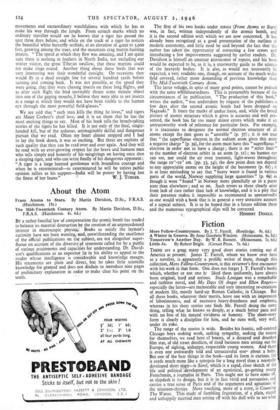About the Atom
From Atoms to Stars. By Martin Davidson, D.Sc., F.RA.S. (Hutchinson. 15s.) The Mid-Twentieth Century Atom. By Martin Davidson, D.Sc., F.RA.S. (Hutchinson. 8s. 6d.)
BY a rather fanciful law of compensation the atomic bomb has tended to balance its material destruction by the creation of an unprecedented interest in microscopic physics. Books to satisfy the layman's curiosity have not been wanting, and, notwithstanding the excellence of the official publications on the subject, are not altogether super- fluous on account of the diversity of treatment called for by a public of various attainments and capacities for understanding. Dr. David- son's qualifications as an expositor lie in his ability to appeal to the reader whose intelligence is considerable and knowledge meagre. His statements are plain and direct, but he takes little scientific knowledge for granted and does not disdain to introduce nine pages of preliminary explanation in order to make clear his point on the tenth. The first of his two books under nonce (From Atoms to Stars) was, in fact, written independently of the atomic bomb, and it is the second edition with which we are now concerned, It has already been recognised as a good presentation of the outlines of modern astronomy, and little need be said beyond the fact that the author has takeif the opportunity of correcting a few errors and introducing a few improvements suggested by earlier readers. Dr. Davidson_is himself an amateur astronomer of repute, and his book would be expected to be, as it is, a trustworthy guide to the science of the heavenly bodies. It is also, as would not necessarily be expected, a very readable one, though, on account of the much wider field covered, rather more demanding of previous knowledge than The Mid-Twentieth Century Atom. The latter vol e, in spite of many good points, cannot be praised with the same w' tcleheartedness. This is presumably because of the circumstances of its publication. " The production of this book," writes the author " was undertaken by request of the publishers a few days after the second atomic bomb had been dropped on Nagasaki." It bears the marks of undue haste, and, while the broad picture of atomic structure which it gives is accurate and well pre- sented, the book has far too many minor errors which make it as untrustworthy work of reference for particular facts. For example, it is inaccurate to designate the normal electron structure of all atoms except the fare gases as " unstable " (p. 37) ; it is not true that " the superfluous electron in the sodium atom gives this atom a negative charge " (p. 39), for the atom must have this " superfluous " electron in order not to have a charge ; there is no " strict limit " to the number of electron orbits in an atom (p. 51) ; no human eye can see, nor could the air even transmit, light-waves throughout the range I0-`-to'' cm. (pp. 53, 54); the dew point does not depend to any appreciable extent on the height of the barometer (p. 62) ; it is at least misleading to say that "heavy water is found in various parts of the world, Norway supplying large quantities" (p. 69) as though it were " fouhd " in Norway more plentifully or in a purer state than elsewhere ; and so on. Such errors as these clearly arise from lack of care rather than lack of knowledge, and it is a pity that their presence makes it impossible to recommend as unreservedly. as one would wish k book that is in general a very attractive account of a topical subject. It is to be hoped that in a future edition these and the numerous typographical slips will be corrected.


























 Previous page
Previous page